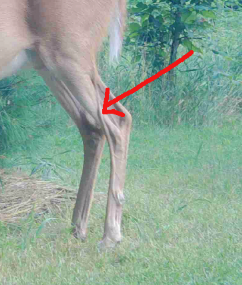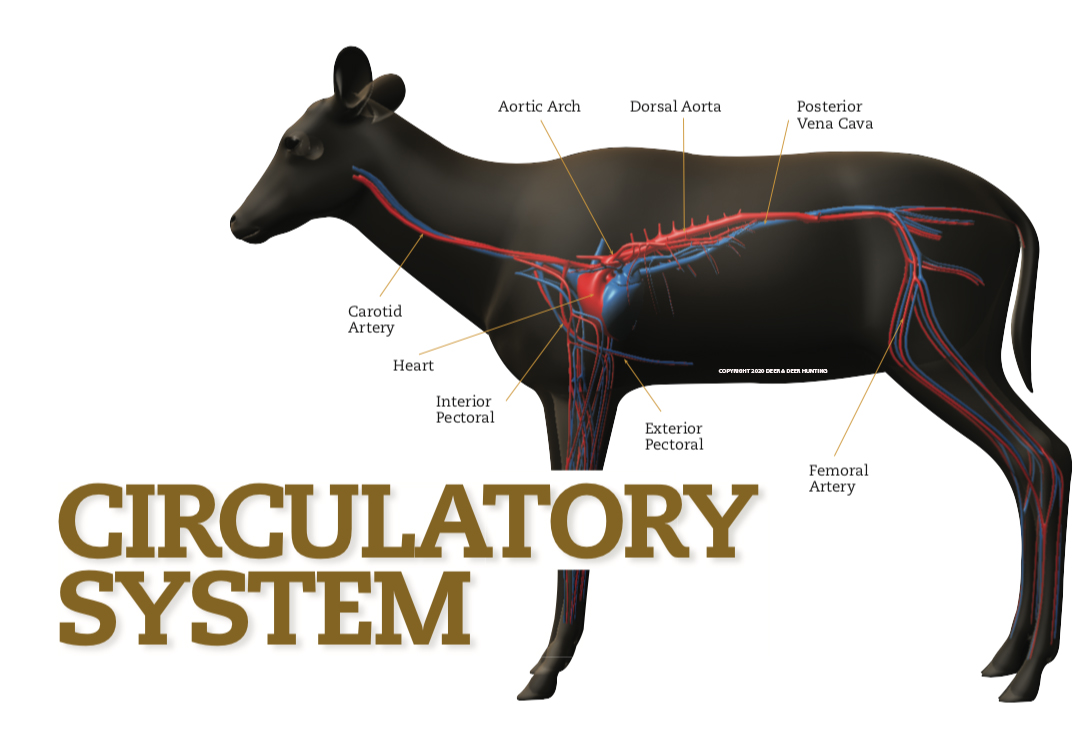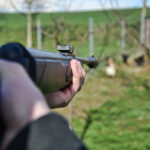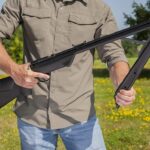Perhaps it’s because I’m an admitted deer geek, but I find whitetail anatomy absolutely fascinating. It’s come to the point where — when I’m hunting and decide I’m going to shoot a deer — I can’t focus on the deer itself.
I start focusing on bits and pieces of the deer. The whitetail’s arteries are among these “bits and pieces.”
Take the femoral artery, for example. That’s the one thing the absolutely jumped out at me the first time I looked at this Browning Trail Camera image of an adult doe. Yes, the doe is awfully pretty — standing there almost broadside (technically slightly quartering to), and she seems to be heading into fall in optimum health.
But just look at that bulging artery in her leg! Quite dramatic, isn’t it?
More About Deer Anatomy
Wisconsin’s Norman Johnson and Alabama’s Dr. Phillip Bishop are two experts in this subject matter, and I’ve had the pleasure of working closely with both of them to help educate millions of whitetail bowhunters on the nuances and associated science connected with femoral artery wounds in deer.
In his work with D&DH, Johnson reminds us of how the upper hindquarters of a deer are a highly blood-rich region, just below where the aorta bifurcates (branches) to a network of other arteries, deep femoral and common femoral arteries, terminating in the lower legs. The vascularity (blood supply) to the entire rear end, including the hams, presents a very effective killing shot for a sharp, well-placed broadhead.
“While working 25 years in the field of radiology directly performing angiography on all parts of the human body, we clearly demonstrated the highly vascular blood supply to this entire region,” he continued. “Man and animal share a direct resemblance in anatomical and physiological makeup, as blood is pumped to all regions of the body. Main arteries resemble the roots of a tree comprised of divisions that branch and re-branch, finally forming smaller vessels. A large enough, razor-sharp broadhead is imperative as an anti-prothrombin (coagulation) measure.”

Both the late John Trout Jr. and Chuck Adams coined the phrase, “The deer (should be) (is) in a big heap of trouble” referring to the rear-end shot. Adams wrote this in his book, “The Complete Book of Bowhunting” (1978): “I’ve personally shot over a dozen deer in the rear-end and none went over 100 yards before keeling over.”
Trout, widely considered one of the foremost experts on blood-trailing whitetails, was more reserved. He said he had recovered many whitetails shot through the hips, even when the femoral artery was missed. He concluded: “Nonetheless, a hip shot is not a shot that any hunter should take intentionally.”
The Whitetail’s Femoral Artery
Dr. Phillip Bishop of the University of Alabama has taught us a lot about deer physiology over the years. The femoral artery topic is one instance where he shed light on what used to be a rather taboo subject, especially among bowhunters.
“Because high blood flow requires high blood pressure, the femoral arteries carry blood under very high pressure when the muscles are working hard,” Bishop writes. “Once the arteries branch several times, they are lined with smooth muscle that can tighten and reduce the diameter of the blood vessels. Every time the vessel diameter is reduced by half, the blood fl ow is reduced by a factor of 16.”
Conversely, he continued, the muscles lining the arteries can also expand, and when the diameter doubles, blood flow increases by a factor of 16. The blood flow increase from smallest to largest is like comparing a garden hose to a fireman’s hose.
“When a large artery, like the femoral artery, is cut, the high arterial pressure causes very rapid blood loss. With every contraction of the heart, the pressure rises and blood is pushed out. In the case of a shotgun slug through the hams, the blood pressure causes the bright red, oxygen-rich arterial blood to spray out impressively, leaving the biggest blood trail we’re likely ever to see from a whitetail.”

When the deer runs or jumps, the pressure rises and the spray is even more widely dispersed.
“The rapid loss of blood from the femoral artery, or any other major artery, causes a rapid and merciful death. Plus, a deer with a major arterial wound that has an exit outside the body will leave an easy blood trail. I have read accounts of deer expiring very quickly when one or both femoral arteries are severed.,” Bishop concludes.
The bottom line: All of these insights should be used to add depth and breadth to your knowledge of white-tailed deer anatomy. Contrary to the opinions of some of my bloodbrothers (and sisters), I would never, ever purposefully shoot a deer “in the ass” on the hopes my broadhead would severe the femoral artery. It is true: A razor-sharp broadhead to the femoral artery will put a deer down quickly, but the odds of this happening on purpose are extremely small. Granted, accidents happen. A twig deflect and arrow. You flinch badly at the shot. Etc. It happens, and if you shoot at enough deer, odds are it will happen to you.
In that event, knowing precisely where the artery is located and how it works are critical pieces of information that can help you decide which next moves to make.
The Mathematics of Deer Blood
The average white-tailed deer of about 150 pounds in live weight carries at least eight pints of blood in its arterial system. For a bowhunter to easily recover a wounded deer, the blood loss must be extensive. A deer will have to lose at least 35 percent of its total blood volume for the hunter to recover it rapidly. That means a loss of at least 2. pints of blood in the case of a 150-pound buck. The quicker the blood loss, the sooner you will recover the animal.
According to Professor Aaron Moen, a deer biologist at Cornell University, a running white-tailed deer has three times the heart rate of a bedded deer.

Why would we want to wait and allow the deer to bed down after being wounded? Any shock the bow-hunter hopes to inflict on a whitetail will only result through great and rapid loss of blood. Applying basic mathematics to his findings on wounded deer behavior, blood loss and shock, University of Pennsylvania researchers once presented us with this interesting and speculative scenario of a hard-hit 150-pound deer leaving a blood trail of l00 yards. They cited an example of a deer wounded to the extent of leaving a very well-defined blood trail indicative of arterial or other heavy bleeding caused by the arrow passing completely through the deer:
“This deer would have to lose 52 ounces, or about 3. pints of blood before collapse,” they reported. “Internal blood loss would have to extend to 41 ounces, or about 2ó pints to stop the deer within the trail distance of 100 yards. In other words, the internal loss rate would have to be almost four times that of the external rate in order to down the deer. Average internal blood loss needed would be .41 ounces per yard; the external rate, .11 ounces per yard.”
Final Thoughts
How far can a deer run before collapsing after a major artery has been severed? How many yards can it run before going down? In his book The Deer of North America, Leonard Lee Rue III estimates that a deer with a major rupture of its arterial system can probably run for approximately 85 to 120 seconds on the oxygen in its bloodstream and brain: “Running at a speed of 35 mph, the deer could potentially run 3,850 feet in 85 seconds, or 5,390 feet in 120 seconds. Although it is not likely that a deer will run this far, the potential exists.”











































